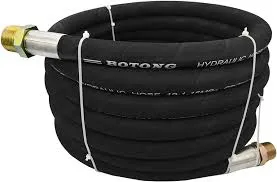335345435
Nov . 11, 2024 15:08 Back to list
industrial air hose
Understanding Industrial Air Hoses Essential Equipment for Every Workshop
Industrial air hoses are a vital component in many sectors, including manufacturing, automotive repair, and construction. These hoses serve as conduits for compressed air, enabling tools and machinery to operate effectively. Understanding the functionalities, types, and maintenance of industrial air hoses is essential for any professional in the field. In this article, we will delve into the critical aspects of industrial air hoses and their importance in various applications.
The Role of Industrial Air Hoses
At its core, an air hose is designed to convey compressed air from a source—such as an air compressor—to pneumatic tools and systems. The efficiency of these tools largely depends on the quality and specifications of the air hose being used. Industrial air hoses must withstand high pressures and remain flexible in various environmental conditions. They serve multiple purposes, including powering air tools, inflating tires, painting with spray guns, and facilitating various manufacturing processes.
Types of Industrial Air Hoses
Industrial air hoses come in an array of types, each tailored to specific applications. The most common materials used include rubber, PVC, and polyurethane.
1. Rubber Hoses Known for their durability and flexibility, rubber hoses can handle high pressures and resist weather conditions, making them ideal for outdoor use. However, they can be heavy and may require more maintenance.
2. PVC Hoses Lightweight and easy to handle, PVC hoses are corrosion-resistant and available in various colors for easy identification. They are often used in low to moderate pressure applications.
3. Polyurethane Hoses These are flexible and lightweight, with excellent abrasion resistance. They are suitable for tight spaces and can withstand a wide temperature range, making them versatile for many applications.
industrial air hose

Additionally, hoses can be categorized based on their diameter, length, and pressure rating. Selecting the right type of hose is essential for maximizing efficiency and safety.
Specifications and Standards
When choosing an industrial air hose, it is critical to consider specifications such as working pressure, burst pressure, and temperature range. The working pressure is the maximum pressure that a hose can safely handle in operation, while burst pressure indicates the point at which the hose may fail. Most professional environments will require hoses that exceed the working pressures of their specific tools for added safety.
Moreover, industrial air hoses must comply with safety standards and regulations set by organizations like the American National Standards Institute (ANSI) or the Occupational Safety and Health Administration (OSHA) in the United States. Compliance ensures safety and reliability, thereby preventing accidents in the workplace.
Maintenance of Air Hoses
Proper maintenance of industrial air hoses is critical to their longevity and performance. Regular inspections for wear and tear can help detect issues early, preventing unexpected downtime and costly repairs. Key maintenance practices include
- Cleaning Keep hoses free from dirt and debris that can clog fittings or affect airflow. - Storage Store hoses in a cool, dry place to prevent damage from UV exposure or extreme temperatures. Coiling hoses without kinks will prevent deformation. - Connection Check Regularly inspect the fittings and connections for leaks, ensuring a secure and safe operation.
Conclusion
Industrial air hoses are indispensable tools in numerous industrial applications. Understanding their types, specifications, and the importance of maintenance can significantly impact the efficiency and safety of operations. By investing in high-quality hoses and adhering to best practices for their care, businesses can ensure seamless operations and minimize downtime, ultimately contributing to greater productivity and success in their respective industries. With the right knowledge and resources, every workshop or industrial setting can maximize the benefits offered by these essential components.
-
SAE 100 R17 Black Smooth Cover Hydraulic Hose
NewsMar.07,2025
-
SAE 100 R17 Black Smooth Cover Hydraulic Hose
NewsMar.07,2025
-
SAE 100 R17 Black Smooth Cover Hydraulic Hose
NewsMar.07,2025
-
SAE 100 R17 Black Smooth Cover Hydraulic Hose
NewsMar.07,2025
-
SAE 100 R17 Black Smooth Cover Hydraulic Hose
NewsMar.07,2025
-
steel wire braided hydraulic hose
NewsMar.07,2025



